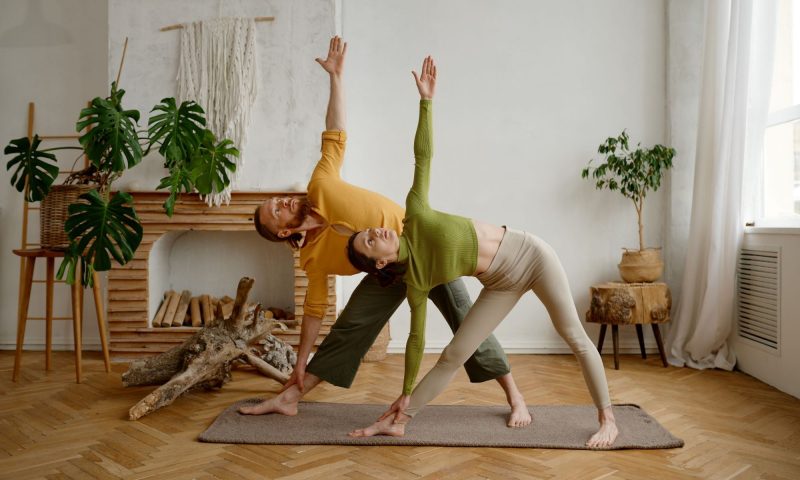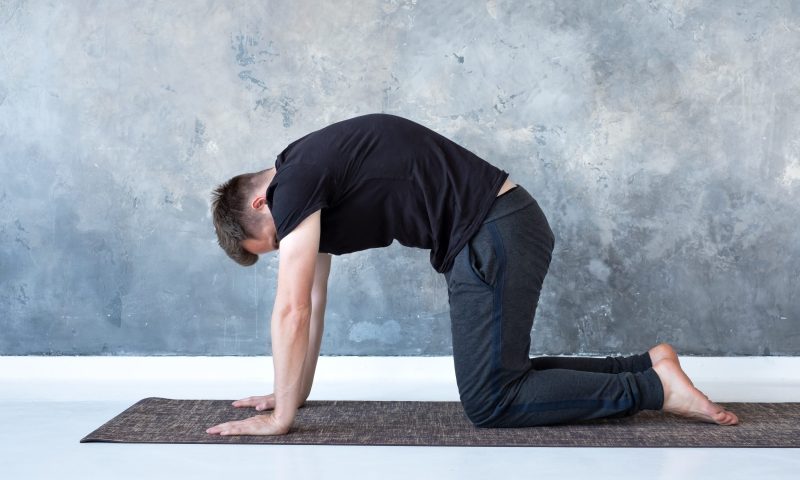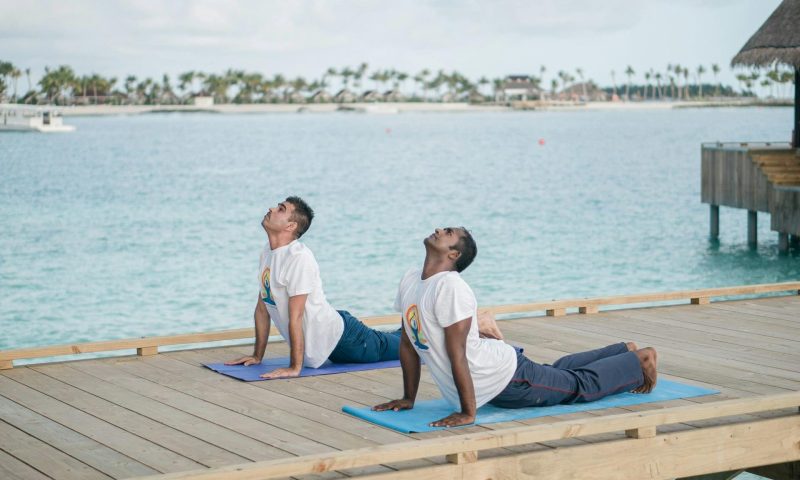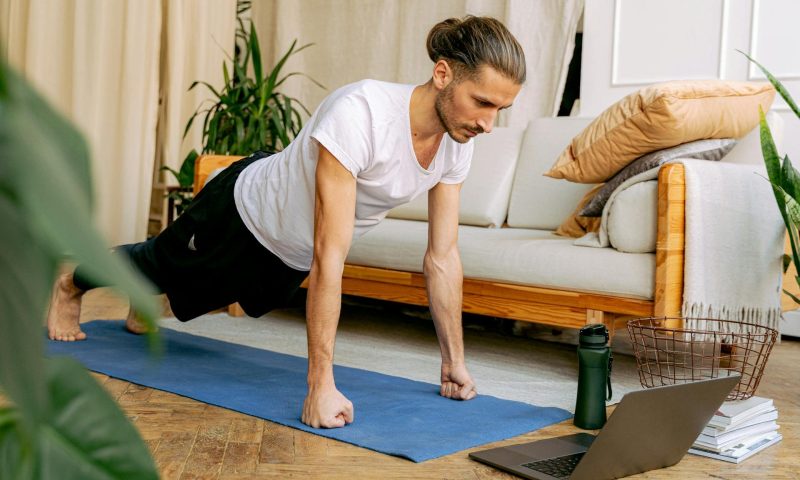When I first tried yoga, I was looking for pain relief and a way to maintain and improve flexibility. I spent countless hours researching wellness and alternative, holistic medicine and therapies, and the more I heard about yoga, the more I wanted to try it. So, I bought a thick yoga mat, started up a beginner yoga DVD I bought at my local Target, and copied what the yoga instructor was doing on screen. I’ve always liked stretching, and the first thing I noticed about this meditative movement practice was how good it felt to stretch my body, even in the most introductory yoga poses like sun salutation and forward fold.
Not only that, I always finish even my shorter yoga sessions in a calmer and more focused state, ideal for a productive day ahead. I’ve used yoga for pain relief, flexibility, meditation, and developing strength for years now. There are different styles and intensities, and yoga has a long and interesting history originating in India and passed down for thousands of years.

I asked professional yoga instructor and experienced yogi Veronica Najera, ERYT-500, to share her top yoga tips for beginners, the different flows, the best poses for lower back pain, and more. Veronica Najera is also the Vice President of Education for YogaSix.
Interview with Master Yoga Trainer Veronica Najera

The Manual: How did you get started on your yoga journey?
Veronica Najera: I discovered yoga by mistake. I used to take a Pilates class with a teacher I loved. One day, I saw the teacher’s name and went to class without realizing it was a Yoga Class, but I fell in love and never looked back! That was almost 17 years ago.
TM: What do you feel are the most important benefits of regular yoga practice?
VN: A regular yoga practice offers a powerful combination of physical, mental, and emotional benefits. Physically, it improves flexibility, strength, balance, and posture while also helping to relieve chronic pain and support heart and lung health.
Mentally, yoga reduces stress, sharpens focus, and promotes a calm, clear mind through breathwork and mindfulness. Emotionally, it enhances self-awareness, emotional resilience, and overall well-being. Over time, yoga fosters a deeper mind-body connection, encourages healthier lifestyle choices, and can even improve your sleep and mood.

TM: How often or how many times a week do you recommend our readers practice yoga? Do you recommend practicing every day?
VN: It’s generally recommended to practice yoga two to three times a week for beginners, gradually increasing to four to five times as you build strength and flexibility. Even short daily sessions can offer significant benefits, especially for stress relief and mental clarity. Consistency is key, so it’s best to find a routine that fits your lifestyle and goals.
TM: There are many different types of yoga flows. What are your top two or three yoga flows, and why?
VN: Two of the most popular and effective yoga flows are Vinyasa and Hatha. Vinyasa is a dynamic, flowing style that links breath with movement, offering a great cardiovascular workout while improving strength and flexibility; it’s ideal for those who enjoy a more active practice.
Hatha, on the other hand, is a slower-paced practice that focuses on foundational poses and alignment, making it perfect for beginners or those seeking a more mindful and restorative experience. A third favorite is Yin Yoga, which involves long-held poses targeting deep connective tissue, promoting relaxation and deep flexibility, which is great for stress relief and recovery.

TM: Do you suggest practicing yoga in the morning or the evening? What are the best yoga flows or poses for waking up?
VN: Practicing yoga in the morning is a great way to energize the body and set a calm, focused tone for the day. Morning flows like Sun Salutations, Cat-Cow, Downward Dog, and Standing Forward Fold gently awaken the spine, improve circulation, and boost alertness. However, the best time to practice is the one you can stick with consistently. Some people prefer evening yoga to unwind and relieve stress. I say it depends on your lifestyle and finding the time that works for you.
TM: What are the best yoga flows or poses for winding down and getting ready for bed?
VN: The best yoga flows for winding down before bed are slow, gentle, and focused on relaxation. Poses like Child’s Pose, Legs-Up-the-Wall, Seated Forward Fold, and Supine Twist help calm the nervous system and release tension from the day.
Cat-Cow and Happy Baby are also great for gently loosening the spine and hips. A short restorative or Yin Yoga flow, holding each pose for two to five minutes with deep, steady breathing, is ideal for preparing the body and mind for restful sleep. Ending with Savasana or a brief meditation can help you fall asleep faster.

TM: Is 30 minutes a day enough to see the benefits?
VN: Of course! 30 minutes a day is enough to experience the benefits of yoga, especially with consistency. A daily 30-minute practice can significantly improve flexibility, strength, balance, and posture. Mentally, it reduces stress, boosts focus, and promotes emotional well-being. Whether you choose a dynamic or a slower flow, half an hour a day can lead to noticeable changes in both body and mind within a few weeks. The key is regular practice, mindful movement, and intentional breathing.
TM: How did you study and train your body to become a Master Yoga Trainer for YogaSix, and why did you decide to become a Master Trainer?
VN: I completed my Yoga Teacher Trainer to deepen my practice and learn how to create flows on my own. I continued to take as many training and workshops as I could to expand my knowledge and practice. But then I taught my first class, and I discovered that I love to share and help others in their yoga journey. I decided to continue on to a teaching path.
That led me to help open the first YogaSix in Texas in 2020 as a Lead Teacher and Operations Manager. Learning about the practice and helping others become teachers was the deciding factor in choosing this career. After I became a Master Trainer, I was offered the position of Director of Education for YogaSix, which later landed me in the role that I have now leading my department as Vice President of Education.

TM: What are your top three yoga poses for developing core strength?
VN: My top three yoga poses for developing core strength are:
- Plank Pose — A foundational pose that activates the entire core, including the deep stabilizing muscles, while also engaging the shoulders and glutes.
- Boat Pose — This pose targets the abdominal muscles, hip flexors, and lower back, building strength and endurance in the center of the body.
- Side Plank — Great for working the obliques and improving balance, this pose strengthens the sides of the core and enhances overall stability.
These poses, when practiced regularly, build a strong and stable core.
TM: What are your top three yoga poses for helping with lower back pain?
VN: My top three yoga poses for helping with lower back pain are:
- Child’s Pose — Gently stretches the lower back and hips, promoting relaxation and relieving tension.
- Cat-Cow Pose — Encourages spinal mobility and releases stiffness by alternating gentle flexion and extension.
- Supine Twist — Helps release tightness in the lower back and improves spinal alignment through a gentle, restorative twist.
These poses soothe and strengthen the lower back, reducing pain and improving flexibility when practiced mindfully.

TM: In addition to yoga, do you advise incorporating other types of exercise into a workout schedule to optimize muscle strength?
VN: I recommend incorporating complementary forms of exercise alongside your yoga practice to optimize muscle strength and overall fitness. While yoga builds incredible functional strength, flexibility, and balance, adding activities like resistance training, Pilates, or even weightlifting can target muscle groups more intensely and promote greater muscle hypertrophy.
Cardiovascular exercises such as running or swimming also enhance endurance and heart health, which supports your yoga practice. It is important to create balance by integrating different movement modalities. Remember, listen to your body and tailor your routine to your individual goals and needs.
TM: What are your top tips for beginners to incorporate yoga practices into their schedules?
VN: For beginners looking to incorporate yoga into their schedules, start with short, manageable sessions around 10 to 20 minutes a few times a week. Choose gentle, beginner-friendly styles like Vinyasa, create a dedicated, quiet space for practice, and focus on consistent, mindful breathing.
Listen closely to your body, modify poses as needed, and set realistic goals that focus on how yoga makes you feel rather than perfecting every pose. Most importantly, be patient and kind with yourself, allowing your practice to grow naturally over time.




